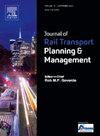多时段铁路时刻表,以满足时效性需求
IF 2.7
Q3 TRANSPORTATION
Journal of Rail Transport Planning & Management
Pub Date : 2025-08-19
DOI:10.1016/j.jrtpm.2025.100536
引用次数: 0
摘要
铁路客运需求每天都在波动,在工作日开始和结束时,由于通勤上学和工作,需求达到峰值。在非高峰期间,游客数量下降,大多数人出于其他目的旅行,如休闲和社交,这导致了不同的旅游目的地。尽管如此,许多欧洲铁路使用固定线路计划和循环时间表,全天保持不变。虽然这种方法使时间表易于记忆,并提供了充足的非高峰旅行选择,但它主要是为高峰时段的需求而设计的,因此在非高峰时段效率较低。此外,由于出行目的的不同组合,基于高峰时段需求的时间表不一定是非高峰时段需求的最佳选择。本文旨在将循环时间表的优点与非循环时间表的灵活性结合起来,以便更紧密地遵循时间依赖性需求。我们提出了一个混合整数线性规划模型,它找到一个由几个时间段组成的一天的时间表,每个时间段都有自己的线路计划。生成的时间表需要在每个周期内循环,并在周期之间提供良好的过渡。利用荷兰铁路网的数据,通过改变停车模式的案例研究,成功地对该模型进行了测试,并找到了最优的时间表。在这个时间表中,循环时间表之间的转换可以在不取消列车或从新的循环时间转移列车的情况下完成。本文章由计算机程序翻译,如有差异,请以英文原文为准。
Multi-period railway timetabling to serve time-dependent demand
Passenger railway demand fluctuates daily, peaking at the start and end of the workday due to commuting to school and work. During the off-peak the volumes drop and most people travel for other purposes, like leisure and social visits, which results in different travel destinations. Despite this, many European Railways use fixed line plans and cyclic timetables that remain constant throughout the day. While this approach makes schedules easy to remember and provides ample off-peak travel options, it is primarily designed for peak-hour demand, making it less efficient for the off-peak. Furthermore, due to the different mix of travel purposes, a schedule based on peak-hour demand is not necessarily optimal for off-peak demand. This paper aims to combine the benefits of a cyclic timetable with the flexibility of an acyclic timetable in order to follow the time-dependent demand more closely. We propose a mixed-integer linear programming model that finds a timetable for a day consisting of several periods which each have its own line plan. The resulting timetable is required to be cyclic within each period and provide a good transition between the periods. The model is successfully tested on a case study with changing stopping patterns using data from the Dutch railway network, for which an optimal timetable is found. In this timetable, the transition between cyclic schedules can be done without cancelling trains or shifting trains from the new cyclic times.
求助全文
通过发布文献求助,成功后即可免费获取论文全文。
去求助
来源期刊

Journal of Rail Transport Planning & Management
TRANSPORTATION-
CiteScore
7.10
自引率
8.10%
发文量
41
 求助内容:
求助内容: 应助结果提醒方式:
应助结果提醒方式:


